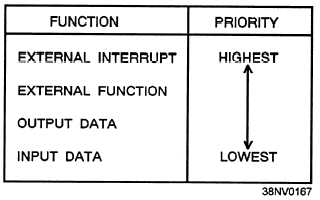read data from memory (output) or write data into
memory (input). The CPU still provides overall
control of the I/O operations, but it is not directly
involved in the actual data transfers between memory
and the external equipments. When the I/O section is
capable of memory access, the CPU provides I/O
commands to an I/O controller (IOC) or processor
and then goes about processing other necessary
operations. The IOC in turn controls all I/O operations
and interrupts the CPU operation when necessary to
inform it of event completion or problems with an I/O
interface channel or external device.
With this method, the CPU concentrates on its
essential business of processing information. We use
the keyboard again as our example. The keyboard is
ready to input characters. The keyboard interface
signals the CPU when a valid character is available in
its INBUF buffer. The CPU is performing some
computational task, when the keyboard sends an
interrupt request that generates an interrupt in the CPU.
When the interrupt request arrives, the CPU leaves its
current task, but not before making arrangements to
save all the data from computations just previous to the
interruption. The CPU leaves its current task and
executes the appropriate service routine. In this case it
receives the input from the keyboard interface and
promptly sends it to the desired location in the
computer. When the information has been routed to its
desired location and the input operation has been
completed, the CPU returns to its previous task.
Review chapter 5 of this volume for a detailed
discussion of the interrupt process.
An interrupt request can occur at any time. To
avoid confusion, most computers use a priority system
for requests in the event that two or more interrupts
arrive simultaneously. Interrupt driven I/Os use a
priority system to honor requests and interrupts. The
priority system is divided into channel and function
priorities. The channel priority performs priority
determination of requests and interrupts based on the
channel number. Figure 7-14 reflects channel priority
of a computer with 16 channels. Notice how they are
grouped and prioritized. Function priority determines
the order of honoring requests and interrupts when
channel priority honors more than one request per
channel. See figure 7-15.
Figure 7-14.—Channel priority determination.
Depending on the type of computer, interrupts are
categorized and the program can be written to meet
specific requirements when an interrupt occurs. Some
interrupt requests cannot be ignored. For example,
when a power failure interrupt occurs, the computer is
given the needed time to save information before the
computer system shuts down.
Direct Memory Access (DMA)
When the CPU is directly involved in each of the
I/O data transfers, it slows down the process of moving
information in and out of the computer. The use of
Figure 7-15.—Function priority determination.
7-16



